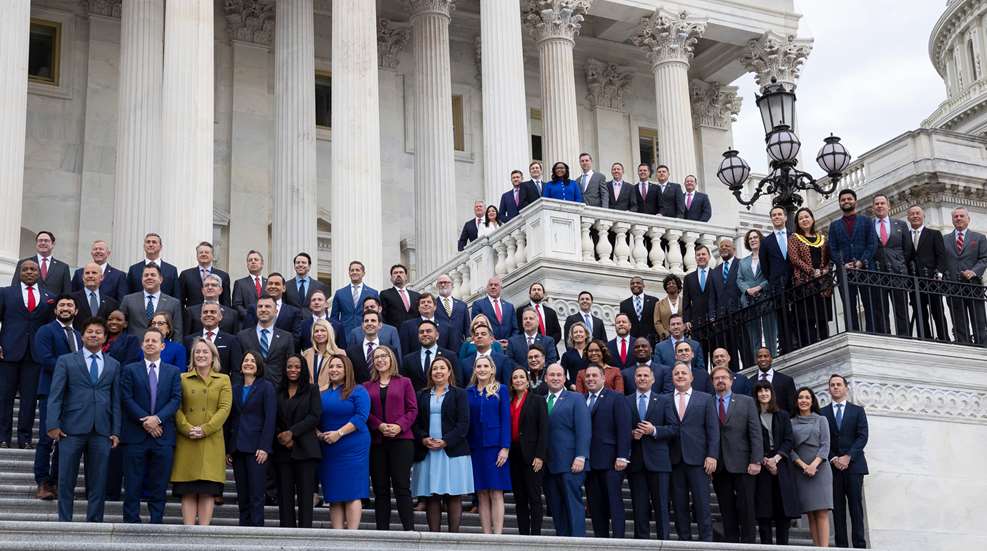
The newly elected members of the U.S. Congress are shown here on the steps of the Capitol Building.
Two things are simultaneously true.
One: That the Republican party did not get the “red wave” that it had hoped for in the 2022 midterm elections. Two: That the Republican party improved its position in Washington, D.C., in the 2022 midterm elections, and thereby made it more difficult for President Joe Biden (D) and his allies in Congress to push through the gun-control measures they desire.
Almost as soon as the voting was over, President Biden announced that he wanted to sign a ban on pretty much every firearm sold in the United States. “The idea that we still allow semi-automatic weapons to be purchased is sick,” Biden told reporters, before promising: “I’m going to try and get rid of assault weapons.” He continued, “I got to make that assessment, as I get in and start counting the votes.”
Let me help him with that: If the Republicans in Congress stay united, those votes do not exist—neither for a ban on “assault weapons,” nor for anything else of consequence. The votes did not exist during the last Congress, in which the Democrats controlled the U.S. House of Representatives and the U.S. Senate, and they are unlikely to exist during this Congress, in which the Republicans control the U.S. House of Representatives and the Democrats control the U.S. Senate. Not only is the new House unlikely to hold votes on an “assault weapons” ban or on “universal background checks,” but, even if it does, the pro-freedom majority should be large enough to absorb any defectors.

In March 2021, the House passed a “universal background check” bill 219 to 210, with two Republicans voting for the measure and two Democrats voting against it. In July 2022, the House passed a ban on so-called “assault weapons” 217 to 213, with two Republicans voting for the measure and five Democrats opposing it. Not all those members were re-elected in November, but, if we take these defections as indicative of legislative sentiment, it seems clear that the same bill would fail in a House that contains nine more Republicans. For the next two years, at least, both of President Biden’s gun-control priorities seem to be dead on arrival in the House.
Bring on the Hearings
Almost as important is that that the U.S. House of Representatives will now be willing and able to perform meaningful oversight of the executive branch. In theory—indeed, by constitutional design—Congress is supposed to keep the president in check, regardless of party affiliation. As James Madison made clear in The Federalist Papers, the responsibilities of the legislature exist without respect to faction or to partisanship. As designed, the Constitution requires Democrat lawmakers to scrutinize Democrat presidents as vigorously as they would scrutinize the Republicans—and vice versa.
In practice, though, it typically takes divided government to get proper oversight. We now have that divided government, and with it a chance to examine the Biden administration’s routine overreach, including in the area of firearms.
History teaches us that this overreach will be forthcoming. Once he was unable to get his agenda through Congress after 2010, President Barack Obama (D) repeatedly attempted to use executive orders to advance further gun control, and, predictably, President Biden has followed suit. In the summer of 2022, Biden boasted that he had “already taken more executive actions to reduce gun violence than any other President during their first year in office.” He was right about the number. Last year, Biden illegally changed the federal definition of a firearm so that it included unfinished parts, such as a handgun’s frame or long gun’s receiver. Currently, Biden is attempting to redefine pistols that are equipped with stabilizing braces so that they are regulated under the 1934 National Firearms Act—and thus require a lengthy background check and $200 tax before they can be purchased or transferred. Those who are currently in lawful possession of pistols affected by the new rule will be subject to the same background check and tax if they hope to remain in lawful possession. Undoubtedly, more shenanigans will follow.
And that’s just the stuff we know about. It was not until Republicans took over the House of Representatives in 2010 that the scale of the Obama administration’s disastrous “Fast and Furious” program became clear. As he promised he would, Biden has staffed his administration with figures who are openly hostile to the Second Amendment. His ATF director is hostile. His surgeon general is hostile. His head of the Department of Health and Human Services is hostile. His attorney general is hostile. Nothing in President Biden’s behavior thus far suggests that he has any respect for the constitutional limits on his power. The American public has given the House of Representatives the opportunity to investigate, and expose, wrongdoing in the executive branch.
What the Senate Can Do Without the House
The Senate is a different story, but, thanks to the Republicans’ victories in the House, the legislative outcome is likely to be the same. Astonishingly enough, the Republican party lost a Senate seat this time around. Previously, the Senate had been tied 50-50, and the vice president had been required to break any ties. In this new Senate, the Democrats control the chamber in full. On paper, this looks as if it might present a major legislative problem, but in reality, it should matter little. For a start, it is not at all clear that there are 50 votes in the Senate for either “universal background checks” or for a ban on the most-commonly owned rifles in America. But, even if there were, the filibuster requires all non-budgetary bills to receive 60 votes, not 50, and there are definitely not 60 votes for draconian gun control. It is true that, with the election of John Fetterman, the Senate now has one more Democrat senator in favor of abolishing the filibuster completely. But, if past positions hold true, there are still not enough Democrats to make that happen, and, irrespective, the incentive to do so was removed by the Republicans winning control of the House. Naturally, there would be no point in the Democrats abolishing the filibuster when their bills could be swiftly killed in the House.
Which is all a long way of saying that, despite the justified disappointment in the Republican Party’s ability to replace more Democrats that opposed the Second Amendment with candidates who support it, advocates of the right to keep and bear arms have emerged from these midterm elections with a legislative veto point and a means by which to hold the Biden administration publicly to account. Unlike for the last two years, President Biden’s ideas will now have to get past divided government, the filibuster and televised congressional hearings. This is an improvement—and, better yet, it is an improvement upon which pro-Second Amendment voters can look to build in 2024.
Come 2024, voters will have a chance to replace the president, to elect a new House and to shift the majority in the Senate in a more-favorable direction.
The news is not all reassuring. The outright loss of the Senate may not have changed the legislative picture a great deal, but it has denied the Republicans the chance to block any of President Biden’s judicial nominees—up to, and including, nominees to the U.S. Supreme Court. The recent Bruen decision represented the single best Second Amendment-related judicial development since the Heller ruling in 2008, but, as with every other matter that is taken into our courts, its holding is only as potent as the judges who are tasked with enforcing it. Aside from Bruen, since 2010, the Supreme Court has been reluctant to take gun cases, preferring to let them bounce around in the lower courts.
This has made it difficult to impossible for many Americans to exercise their freedom. Biden doesn’t mind that. He has made it clear that he wants to severely the limit the scope of the Second Amendment. He said, of D.C. v. Heller, that “if I were on the court, I wouldn’t have made the same ruling.” He has said that he is “deeply disappointed” by the ruling in Bruen, which he believes “contradicts both common sense and the Constitution.” He has also said that “the Second Amendment is not absolute”—by which he means that any restriction he can dream up should be presumed to be legal.
If, in the next two years, Biden gets the chance to nominate another U.S. Supreme Court justice, he will pick one who shares his view on the Second Amendment, who will seek to undermine the holdings in Heller, McDonald and Bruen, and, if given the chance, to reverse them completely. In the meantime, he will use his new Senate majority to fill the lower courts with judges likely to thwart the right to keep and bear arms at every opportunity, in the hope that the Supreme Court will let their recalcitrance stand.
From their position in the minority in the U.S. Senate, Republican senators cannot stop this—or even slow it down. But they can raise the political cost of Biden’s agenda by making it clear to the public that the judges he is choosing—and that the Senate is approving—are out of step with both the preferences of the voting public, and, more importantly, with the plain text of the U.S. Constitution. Polling shows that 80% of Americans understand that the Second Amendment protects an individual right to keep and bear arms. The claim that the Second Amendment protects some mythical “collective right”—or that it protects nothing much at all—is absurd and extreme, and Republicans who care about the maintenance of the right as it was written and understood by the Founders must put as many of Biden’s nominees on the record regarding the question as is possible.
And, if they are unsatisfied with what they hear, they must vote against those nominees, so that, if they are elevated to higher positions within the judiciary, there is a paper trail recording earlier objections. In recent years, ostensibly pro-Second Amendment senators have voted for judges who they know full well are a threat to the exercise of the right to keep and bear arms, without so much as laying down a marker to be used in future fights. This must end. Like Senate majorities, judicial victories are won over years—even decades. Currently, the Republicans are unable to prevent Biden’s excesses in the judicial realm. But this can change. When it does, those Republicans will find it useful to have kept up with their homework along the way.
What the Future Holds
Going forward, voters who wish to maintain their hard-won restoration of the right to keep and bear arms ought to remember that, while the 2022 elections did not bring the solid pro-Second Amendment majority for which they had hoped, there will be another election in just two years’ time, at which every part of the federal government can be altered. Come 2024, voters will have a chance to replace the president, to elect a new House and to shift the majority in the Senate in a more-favorable direction. The work in support of this aim must begin now. We are going to need excellent candidates who have been thoroughly vetted for their true views on gun control; we are going to need model legislation that is ready to go on day one; and, above all, we are going to need to spend the next two years making the case for our positions both inside and outside of the political realm.
It is disappointing that we will spend 2023 and 2024 engaged in yet more trench warfare—defending here, blocking there, advancing on the rare occasions that the shelling is brought to a halt—but it is also an opportunity to ask the American public a simple question: “Do you really want more of this?”

































